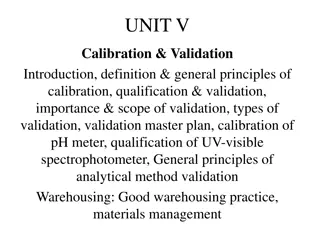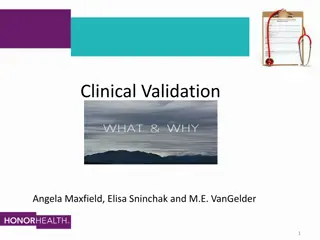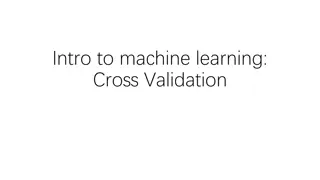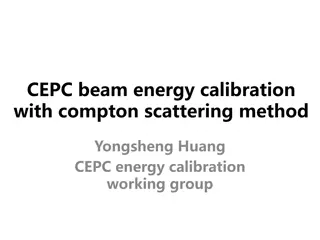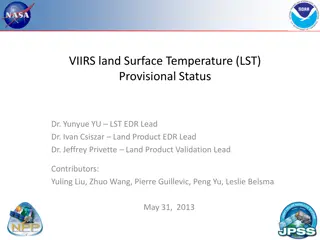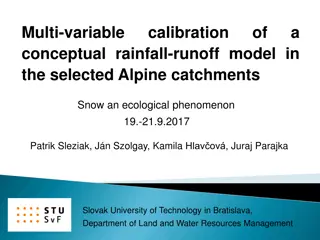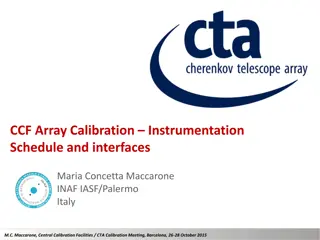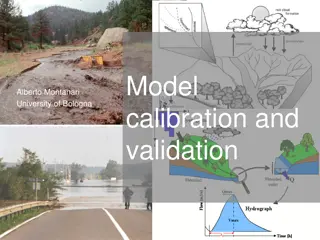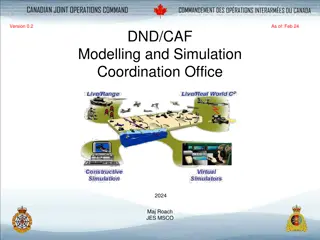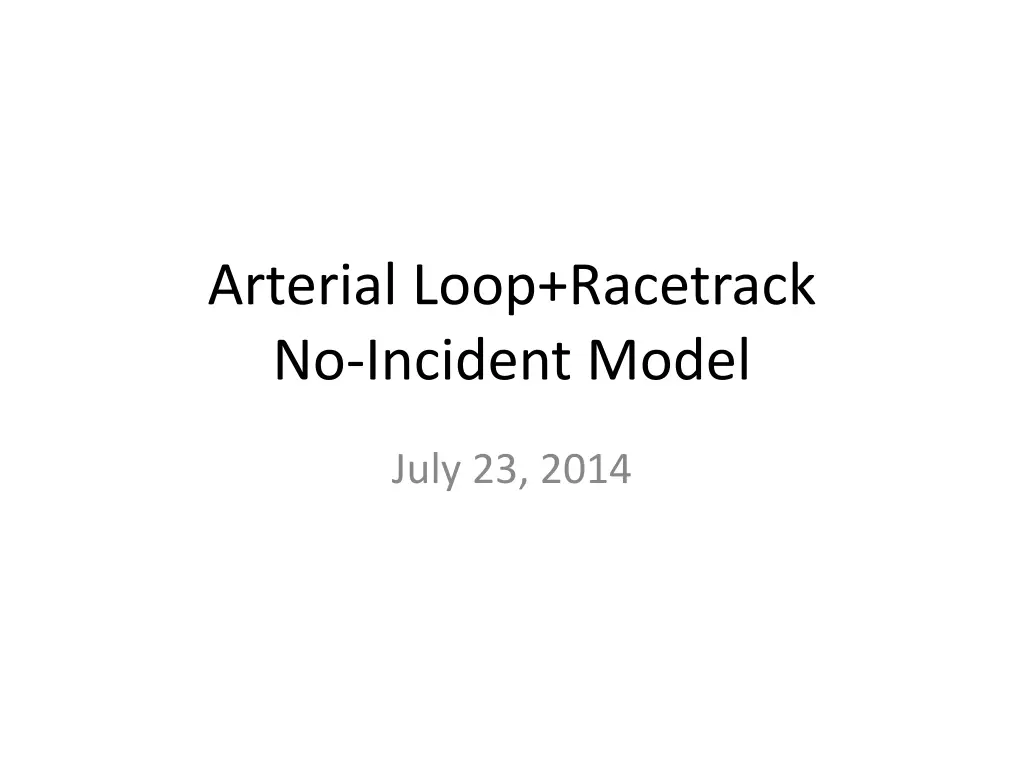
Arterial Loop Racetrack No-Incident Model Insights
Gain insights into the Arterial Loop Racetrack No-Incident Model components, data processing, and forward simulation metrics. Explore input details for the simulation, calibration checks, and split ratios generation for a detailed understanding of the model's operation.
Download Presentation

Please find below an Image/Link to download the presentation.
The content on the website is provided AS IS for your information and personal use only. It may not be sold, licensed, or shared on other websites without obtaining consent from the author. If you encounter any issues during the download, it is possible that the publisher has removed the file from their server.
You are allowed to download the files provided on this website for personal or commercial use, subject to the condition that they are used lawfully. All files are the property of their respective owners.
The content on the website is provided AS IS for your information and personal use only. It may not be sold, licensed, or shared on other websites without obtaining consent from the author.
E N D
Presentation Transcript
Arterial Loop+Racetrack No-Incident Model July 23, 2014
Outline Arterial Loop+Racetrack No-Incident Model Model components (with calibration set) Model run Model validation (with validation set) 2
Data Processing Model Components: FD / BF / SR / Signals Model Components CTM Forward Simulation Metrics: TT, Delay, LOS, VHT, VMT Comparison: Travel Time, Flow Generate FD Fixed capacity Fixed jam density Speed limit from Nokia map cc-network - - FD Racetrack flow 1 Racetrack SR 2 SR, BF SR/BF Calibration cc-scenario building Loop flow 3 Loop SR 4 Signal Timing 6 cc-scenario 3
[ Input for CTM Forward Simulation of Arterial Loop+Racetrack No-Incident Model ] Family of Fundamental Diagrams Fixed jam density = 150 veh/km/lane Fixed capacity = 1800 veh/hr/lane Free flow speed = speed limit from Nokia maps Flow Density 4
[ Input for CTM Forward Simulation of Arterial Loop+Racetrack No-Incident Model ] SR/BF Calibration Check whether side street BF reasonable Apply engineering judgment SR Racetrack SR 2 BF SR BF Generate BF profile Set SR Optimization loop SR 4 Default SR Target flows Flow loop flow 3 Time Racetrack flow where loop is not available at the same location Scale racetrack flow 1b Generate Generic flow profile Racetrack flow where loop is available at the same location loop flow 3 1a Default BF 5
[ Input for CTM Forward Simulation of Arterial Loop+Racetrack No-Incident Model ] Process to Generate Split Ratios 1. Use racetrack data 2. Use default values when racetrack data unavailable 3. Apply engineering judgment to obtain reasonable boundary flows in subsequent steps 6
[ Input for CTM Simulation of Arterial Loop+Racetrack No-Incident Model ] 10% 90% I210W Split Ratios 69% 31% Color coding: Racetrack data Default values 49% 44% 18% 24% 58% 90% Engineering judgment Split ratio from loop 100% 7% 10% 90% 90% 11% 93% 7% 45% 55% Colorado Blvd 10% 10% 77% Colorado Blvd 12% 50% 50% 50% 50% 7% 22% 71% 6% 94% Michillinda Baldwin / Oxford 50% 50% 19% 82% 8% 73% 18% 17% 11% 72% 10%90% 100% 26% 74% 50% 50% Colorado Pl 92% 8% 100% 10%90% 10% 73% 6% 75% 5% 90% 46% 54% 2% 98% 10% 90% 10% 90% 10% 90% 23% 77% 35% 65% 17% 19% 5% 5% 5% 90% 5% 3% 10% 90% 100% 100% 90% 10% 95% 68% 60% 37% 91% 27% 5% 6% 10% 90% Huntington 50% 50% 7% 56% 37% 10% 90% 50% 50% 17% 19% 64% 50% 33% 8% 41% 51% 7 Santa Clara Santa Anita 1st 2nd Gateway 5th I210E I210W
[ Input for CTM Forward Simulation of Arterial Loop+Racetrack No-Incident Model ] Reasons for finetuning split ratios with Engineering judgment @ 1st both Northern and Southern approaches: change split ratio from [ left=10%, thru=90%, right=0% ] to [50%, 50%, 0%] Side street is small; it is therefore unlikely that many drivers go thru; instead, they most likely turn towards the main street @ 5th N/S: ditto 8
[ Input for CTM Forward Simulation of Arterial Loop+Racetrack No-Incident Model ] Reasons for finetuning split ratios with Engineering judgment @ Santa Anita South: change from [ left=17%, thru=64%, right=19% ] to [17%, 50%, 33%] Too little traffic predicted on Huntington at 2nd W Further hypothesis: After racetrack event, people leave via Santa Anita (among others) and want to go to the freeway. The split ratio estimated by the racetrack study are therefore overestimated in the thru direction. 9
[ Input for CTM Forward Simulation of Arterial Loop+Racetrack No-Incident Model ] Reasons for finetuning split ratios with Engineering judgment @ Huntington & Colorado East: change from [ left=77%, right=23% ] to [ 54%, 46% ] Too little traffic predicted on Colorado & Colorado SE Analysis of loop data at advance and left-turn locations showed that splitratios differ a lot between loops and racetrack study 10
[ Input for CTM Forward Simulation of Arterial Loop+Racetrack No-Incident Model ] Reasons for finetuning split ratios with Engineering judgment @ 2nd West: change from [ left=3%, thru=91%, right=6% ] to [3%, 60%, 37%] : Too much traffic predicted on Huntington at I210E and I210W Further hypothesis: After racetrack event, people leave via Huntington (among others) and want to go to the freeway. The split ratio estimated by the racetrack study are therefore overestimated in the thru direction. 11
[ Input for CTM Forward Simulation of Arterial Loop+Racetrack No-Incident Model ] SR/BF Calibration Check whether side street BF reasonable Apply engineering judgment SR Racetrack SR 2 BF SR BF Generate BF profile Set SR Optimization loop SR 4 Default SR Target flows Flow loop flow 3 Time Racetrack flow where loop is not available at the same location Scale racetrack flow 1b Generate Generic flow profile Racetrack flow where loop is available at the same location loop flow 3 1a Default BF 12
[ Input for CTM Forward Simulation of Arterial Loop+Racetrack No-Incident Model ] Process to Generate Boundary Flows Overview 1. Generate static (constant in time) boundary flows using an optimization procedure 2. Generate generic flow profile based on loop data 3. Scale generic flow profile of step 2 by optimal values obtained in step 1 13
[ Input for CTM Forward Simulation of Arterial Loop+Racetrack No-Incident Model ] Process to Generate Boundary Flows Step 1 Generate static boundary flows using an optimization procedure Decision variables: boundary flows Data: Split ratios as specified previously Target flows to match Measured flows from loop (calibration dataset), where available Flows from racetrack study, then scaled down by 6% or down by 35% Default values, when loop and racetrack data unavailable Objective: minimize RMSE between simulated and target flows weight of measurement Set of locations where target flows are available 14
[ Input for CTM Forward Simulation of Arterial Loop+Racetrack No-Incident Model ] Process to Generate Boundary Flows Step 1 Choice of weight values wij in objective function Based on data credibility Loops 2014: are considered very credible w = 1 Racetrack 2006: used if loop not available w = 1 Default values: not very credible, used to nudge system towards realistic values w = 0.2 weight of measurement Set of locations where target flows are available 15
[ Input for CTM Forward Simulation of Arterial Loop+Racetrack No-Incident Model ] Color coding: Target Flows used in Boundary Flow Optimization Program to Minimize Error to Simulated Flow Hourly flow from loop (calibration dataset) Hourly flow from racetrack, scaled down by 35% Hourly flow from racetrack, scaled down by 6% I210W 812 517 Default values 1297 Colorado Blvd 1087 210 553 Colorado Blvd 200 200 477 Michillinda Baldwin / Oxford Colorado Pl 223 200 200 670 200 519 230 322 1193 792 708 766 940 1030 803 1065 1016 736 814 1035 1270 415 100 370 200 Huntington Santa Clara Santa Anita 1st 2nd Gateway 5th I210E I210W 16
[ Input for CTM Forward Simulation of Arterial Loop+Racetrack No-Incident Model ] Optimal Static Boundary Flows that minimize error between simulated and target flows 823 I210W Baldwin / Oxford 1347 Colorado Blvd Colorado Blvd 127 78 129 567 Michillinda 709 518 89 150 220 Colorado Pl 173 332 228 1028 Huntington 200 1059 364 487 166 19 Santa Clara Santa Anita 1st 2nd Gateway 5th I210E I210W
[ Input for CTM Forward Simulation of Arterial Loop+Racetrack No-Incident Model ] Process to Generate Boundary Flows Steps 2 and 3 Step 2: Create generic flow profile Flow Boundary Flow Profile used in Forward Simulation Step 3: Scale generic flow profile of step 2 by optimal values obtained in step 1 220 16:00 20:00 Time 20
[ Input for CTM Forward Simulation of Arterial Loop+Racetrack No-Incident Model ] Signal Timings 11 intersections: use given plans 2 intersection: invented reasonable plans Michillinda Baldwin / Oxford 1st 2nd 5th I210E Gateway I210W Santa Anita 21
Outline Arterial Loop+Racetrack No-Incident Model Model components (with calibration set) Model run Model validation (with validation set) 22
[ Output from CTM Forward Simulation of Arterial Loop+Racetrack No-Incident Model ] Westbound traffic on Huntington and Colorado 23
[ Output from CTM Forward Simulation of Arterial Loop+Racetrack No-Incident Model ] Eastbound traffic on Huntington and Colorado TODO: Scale the verticle axis properly 24
Outline Arterial Loop+Racetrack No-Incident Model Model components (with calibration set) Model run Model validation (with validation set) 25
Data Processing Comparison Model Components: FD / BF / SR / Signals CTM Forward Simulation Data Processing Metrics: TT, Delay, LOS, VHT, VMT Comparison: Travel Time, Flow Calibration Data Set Validation Data Set The Model Bluetooth Travel time 5 Loop flow 3 Comparison: Travel Time, Flow March: 3, 11, 13, 17, 18, 19, 25, 26, 31 April: 3, 14, 16, 23, 28, 29 Calibration Days May: 5, 6, 8, 12, 13, 15 Validation Days 26
[ Validation of CTM Forward Simulation of Arterial Loop+Racetrack No-Incident Model ] Simulated vs. Measured Flows Comparison of Flow (run#4877); RMSE = 110.5 veh/h 1400 Based on calibration dataset Based on validation dataset Average CTM Flow Average Loop Flow 1200 1000 Flow [veh/h] 800 600 400 200 0 H&C NW H&C E SC E SC W SC N SA E SA S SA W SA N 1st E 2nd E 2nd S 2nd W 2nd N Location of Loop Detector Huntington 27
[ Validation of CTM Forward Simulation of Arterial Loop+Racetrack No-Incident Model ] Simulated vs. Measured Flows, 16:00-17:00 Comparison of Flow: Measurement vs. CTM (run#4877), 16:00 - 17:00 1400 Average Hourly Flow CTM Average Hourly Flow Loop 1200 1000 Flow [veh/h] 800 600 400 200 0 H&C NW H&C E SC E SC W SC N SA E SA S SA W SA N 1st E 2nd E 2nd S 2nd W 2nd N Location of Loop Detector Individual link flows Passed cases Targets Flow within 100 vph for link flows < 700 vph 4/5 = 80% > 85% Flow within 15% for 700 vph < link flows < 2700 vph 6/9 = 67% > 85% Flow within 400 vph for link flows > 2700 vph 0/0 > 85% GEH statistics < 5 10/14 = 71% > 85% Sum of all link flows Results Targets Relative Error in Total Flow 3.7% < 5% GEH 3.1 < 4 28
[ Validation of CTM Forward Simulation of Arterial Loop+Racetrack No-Incident Model ] Simulated vs. Measured Flows, 17:00-18:00 Comparison of Flow: Measurement vs. CTM (run#4877), 17:00 - 18:00 1400 Average Hourly Flow CTM Average Hourly Flow Loop 1200 1000 Flow [veh/h] 800 600 400 200 0 H&C NW H&C E SC E SC W SC N SA E SA S SA W SA N 1st E 2nd E 2nd S 2nd W 2nd N Location of Loop Detector Individual link flows Passed cases Targets Flow within 100 vph for link flows < 700 vph 4/5 = 80% > 85% Flow within 15% for 700 vph < link flows < 2700 vph 6/9 = 67% > 85% Flow within 400 vph for link flows > 2700 vph 0/0 > 85% GEH statistics < 5 10/14 = 71% > 85% Sum of all link flows Results Targets Relative Error in Total Flow 2.9% < 5% GEH 3.1 < 4 29
[ Validation of CTM Forward Simulation of Arterial Loop+Racetrack No-Incident Model ] Simulated vs. Measured Flows, 18:00-19:00 Comparison of Flow: Measurement vs. CTM (run#4877), 18:00 - 19:00 1200 Average Hourly Flow CTM Average Hourly Flow Loop 1000 800 Flow [veh/h] 600 400 200 0 H&C NW H&C E SC E SC W SC N SA E SA S SA W SA N 1st E 2nd E 2nd S 2nd W 2nd N Location of Loop Detector Individual link flows Passed cases Targets Flow within 100 vph for link flows < 700 vph 10/10 = 100% > 85% Flow within 15% for 700 vph < link flows < 2700 vph 3/4 = 75% > 85% Flow within 400 vph for link flows > 2700 vph 0/0 > 85% GEH statistics < 5 13/14 = 93% > 85% Sum of all link flows Results Targets Relative Error in Total Flow 5.0% < 5% GEH 4.7 < 4 30
[ Validation of CTM Forward Simulation of Arterial Loop+Racetrack No-Incident Model ] Simulated vs. Measured Flows, 19:00-20:00 Comparison of Flow: Measurement vs. CTM (run#4877), 19:00 - 20:00 1000 Average Hourly Flow CTM Average Hourly Flow Loop 800 Flow [veh/h] 600 400 200 0 H&C NW H&C E SC E SC W SC N SA E SA S SA W SA N 1st E 2nd E 2nd S 2nd W 2nd N Location of Loop Detector Individual link flows Passed cases Targets Flow within 100 vph for link flows < 700 vph 8/12 = 67% > 85% Flow within 15% for 700 vph < link flows < 2700 vph 2/2 = 100% > 85% Flow within 400 vph for link flows > 2700 vph 0/0 > 85% GEH statistics < 5 10/14 = 71% > 85% Sum of all link flows Results Targets Relative Error in Total Flow 22.4% < 5% GEH 17.0 < 4 31
[ Validation of CTM Forward Simulation of Arterial Loop+Racetrack No-Incident Model ] Simulated vs measured travel times Simulated WB travel time from Gateway to Santa Clara averages 147s between 4pm 6pm Measured WB Bluetooth travel time (validation dataset) averages 153sbetween 4pm 6pm From: Huntington_Gateway; To: Huntington_SantaClara CTM run 4877 Bluetooth 220 200 180 Travel Time [sec] 160 140 120 100 80 16:00 16:30 17:00 17:30 18:00 32 Time of day [hr]
[ Validation of CTM Forward Simulation of Arterial Loop+Racetrack No-Incident Model ] Simulated vs measured travel times 16:00-17:00 200 Average Hourly Travel Time CTM Average Hourly Travel Time Bluetooth 180 Journey time within network Passed cases Targets 160 Within 15% or 1 minute, whichever criteria is higher 1/1 = 100% 140 > 85% Travel Time [seconds] 120 100 17:00-18:00 80 Journey time within network Passed cases 60 Targets 40 Within 15% or 1 minute, whichever criteria is higher 1/1 = 100% > 85% 20 0 16:00-17:00 17:00-18:00 33


